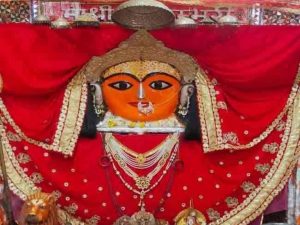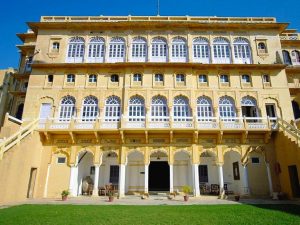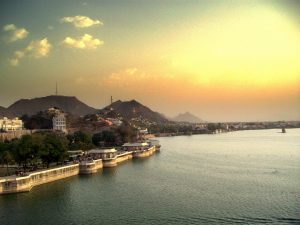“The world is a book and those who do not travel read only one page.”
– Augustine
In an attempt to explore the world, people often tend to neglect the places that are less talked about, that are not considered to be “as beautiful as compared to other spots of attraction.” Such places have a lot more exciting to offer, stories that survive in solitude, the beauty that is hidden in deeps of lands. One such underrated destination lies in the deserts of ‘Rajasthan, the Royal State.’ It is on this land where water is scarce lies the Sambhar Salt Lake, whose beauty shimmer the eyes of the viewer. Let us go through the beauty of this wonder of nature and explore the unexplored stories of the place.
Sambhar Salt Lake
The largest inland saltwater lake in India lies in the heart of Rajasthan, the Sambhar Salt Lake. It surrounds the old Sambhar Lake Town and is 80 kilometres southwest of Jaipur and 64 kilometres northeast of Ajmer in Rajasthan. The catchment area of Sambhar Lake is 5700 square kilometres. Also, a 5.1-kilometre-long dam splits the lake that aids in the salt production process.
The Lake is oval, fed by five rivers: Medtha, Samaod, Mantha, Rupangarh, Khari, and Khandela. The lovely Aravalli Mountains provide a backdrop to the landscape, adding to its splendour. In addition, the Sambhar Lake Town has a few tourist attractions that attract nature lovers, birdwatchers, photography enthusiasts and all kinds of tourists.
Designated as a Ramsar Site, the stories of the lake and the Sambhar Town, however, often go unheard. Places in and around Sambhar Lake-town is worth visiting, as they are an amalgamation of heritage, culture, nature and provides opportunities to see the wonders of technology.
You may also like to read about: SALT RITUALS- SCIENTIFIC & CULTURAL FACTS YOU MUST KNOW
History of Sambhar Lake
The history of Sambhar Lake dates back to the era of Mahabharata as part of the kingdom of the demon king Vrishparva, as well as the home of his priest Shukracharya and the location of his daughter Devayani’s wedding to King Yayati. The honouring of Devayani took place beside the lake.
According to mythology, Shakambhari Devi, the tutelary goddess of the Chauhan Rajputs (Prithviraj Chauhan) and Lord Shiva’s consort transformed a dense forest into a silver plain as recompense for some duty. She turned the silver plain into a lake at the request of the locals, who feared the greed and turmoil that such a property would bring. The lake’s name, “Sambhar,” is sourced from a variation of Shakambhari that occurred about the sixth century. Another temple near the lakefront is dedicated to Shakambhari Devi.
The Sambhar Lake-Town is the very place where Jodha Bai (or Mariam-uz-Zamani) was married to the Mughal emperor Akbar. As part of small-scale excavation operations in Sambhar Lake in 1884, ancient sculpture art was uncovered in the vicinity. Terracotta structures, coins, and seals, as well as a clay stupa, were discovered during the dig. A large-scale systematic and scientific excavation was then done about 1934, yielding a considerable quantity of terracotta figurines, stoneware, and adorned discs.
You may also like to read about: Kerala backwaters tour and explore boathouse
Ecology and Wildlife of Sambhar Lake
Apart from being a Ramsar Site (recognized wetland of international importance), the Sambhar Salt Lake is India’s largest saline lake and the primary source of salt in Rajasthan. It produces 196,000 tons of clean salt per year, accounting for about 9% of India’s total salt output. The government-owned corporation Sambhar Salts Ltd. (SSL), a joint venture of Hindustan Salts Ltd. and the state government, manages the majority of the salt production. SSL has a 3% stake in the eastern lake.
However, the concentration of salt in the lake differs seasonally. It is majorly due to the bloom of haloalkaliphilic bacteria that the salt concentration in the pans (kyars) changes and the colour of the brine ranges from green, orange, pink, purple, pink, and red.
The wetland also has a flourishing avifauna habitat. One can experience the beauty of thousands of pink flamingos (specifically) and other birds like pochards, shovellers, common teal, and others. However, these birds migrate to the marsh during the winter season from far away locations such as Northern Asia and Siberia. These waterfowl birds thrive on the bacteria and algae that thrive in the lake. In addition, they give the water a lovely, scenic colour and aid in environmental preservation.
Furthermore, there are deep woods in the neighbourhood of the lake that are home to a variety of wildlife, including nilgais, deer, and foxes. Thus the lake becomes a prominent part of the town along with being a place that tourists can look forward to visiting and at the same time admire the beauty of nature.
How to reach the Sambhar Salt Lake?
The Jaipur airport is 118 kilometres from Sambhar. The airport is well-connected to all major domestic and international airline routes and destinations. One can use any transportation, like private/public buses and taxis to reach Salt Lake and its various attractions from the airport.
The nearest train station is Sambhar Salt Lake, which is also connected to the Jaipur Railway Station. On an hourly basis, many trains run to Jaipur. However, not many trains stop at the Sambhar Salt Lake Station.
It is viable to opt for a bus journey or travel through the road, either from Nagaur or Kuchaman or from Jaipur Sindhi Camp Bus Stand. The first stop is Sambhar, where you can disembark. It is also connected to Malhan, which immediately connects to Jaipur (NH-8).
Best time to visit
Because of two factors, the best time to visit Sambhar is from November to March, i.e. during the winter season. To begin with, the weather is moderately chilly and pleasant, with no heat waves to burn your skin or cause discomfort. Second, winter is the migration season for birds. Beautiful birds from faraway lands are flocking to the area at this time. Summers, on the other hand, can be extremely hot, with temperatures as low as 45 degrees Celsius.
You may also like to read about: Hawa Mahal- history, facts and architecture
Things to do at Sambhar Lake
Not only the lake and its ecology but certain other things will keep you engaged throughout your visit to the place. Here are some things or activities that you can enjoy during your visit to Sambhar Lake: –
1. Bird watching
One of the top activities at Sambhar Lake is Birdwatching. Thousands of migratory birds visit the marsh during the winter season, and you can discover all kinds of domestic and exotic species resting here, so it becomes a significant pastime. Out of all these beautiful creatures, the pink flamingos are the largest lot. It draws a large number of birding enthusiasts to the area. All you’ll need is a pair of binoculars and possibly a seat mat.

2. Camping
Yet another fun and popular activity at Sambhar Lake is Camping. Many people come here to camp and observe the pristine night skies since the place reverberates with serenity and calm and also provides amazing sunset views. Because the lake is bordered by highways, finding a suitable camping spot is simple. Just make sure it’s completely dry and far enough away from the water.
You can either avail an offer from the many camping sites or pitch a tent of your own. However, you need to take the permission of the local authorities.
3. Driving Around the Lake
Driving around the spot is one of the favorite pastimes of the visitors. A lot of people prefer to just drive around the spot since it is so pretty and mesmerizing; they can have a watch at the Aravallis in the backdrop and drive on narrow trails. It is best to keep on the wooden tracks if you are riding a bike or a motorcycle. But if you are travelling about in a car, you can go farther into the woods.
4. Visit Shakhambari Mandir
Situated on the southern bank of the lake is the Shakhambari Mandir. It should be on one’s bucket as the temple provides stunning views of the lake as well as the salt piles from a distance. Here you can enjoy listening to the priests’ fascinating stories and mythological facts. They may also be aware of some bird colonies, which you might seek out.

5. Trolley Ride
A trolley ride is another option for visitors to enjoy the site, facilitated by Sambhar Salts Limited. For a few hours, the fee is roughly INR 500. You can also go on a sightseeing trip to the entire area.
6. Photography
Capturing the breathtaking scenes is the best thing to do around the lake. The birds, the scenic views of salt mountains and the desert provide a beautiful panoramic vista of the land. Photographers throng to the area to capture the scenery, especially during the winter months when the lake is teeming with migratory birds.
Places to visit near Sambhar lake-town
There are plenty of places or tourist destinations to visit along with Sambhar Lake. These places either lie around the Sambhar Lake town or in the same district. Visitors can enjoy a lavish stay at one of the heritage hotels, at reasonable costs and enjoy all the week round.
1. Roopangarh Fort
The Roopangarh Fort, a palace and old fortification in the town of Roopangarh, is a grand monument that has been transformed into a colourful Heritage Hotel. Maharaja Roop Singh of Kishangarh constructed the Fort in 1648. Kishangarh Railway Station is roughly 23 kilometres from Roopangarh Fort.

2. Kishangarh City
Kishangarh, also popular as India’s marble city, is a tourist destination in and of itself. Kishangarh is located 30 kilometres from Ajmer and 90 kilometres from Jaipur. The city’s art and culture, as well as the Bani Thani School of painting and the Kishangarh Fort, are eminent. It is the only spot on the globe with a nine-planet temple. The city’s principal attractions include the Khoda Ganesh Ji temple, Kishangarh Fort, Phool Mahal Palace, and Gondulav Lake.

3. Nareli Jain Temples
Nareli Jain Temple is a stunning marble temple located around 7 km from Ajmer with angular and highly appealing decorations. The temple is located in the Aravali Mountain ranges. The temple’s views are more picturesque because of its location. With 24 small temples (Choubisi) lined up on the hill above, this Temple has a remarkable exterior combining ancient and contemporary architectural styles.
4. Shopping in Ajmer
Tourists frequent the local street markets and purchase traditional items that reflect Rajasthan’s beauty and culture. Embroidered apparel and shoes, silver and lac jewellery, black metal showpieces, handmade jute bags, and other lovely mementoes may be found in Ajmer’s bustling markets.
5. Ana Sagar Lake
The beautiful Ana Sagar Lake is a lovely constructed lake in the city of Ajmer, Rajasthan, India. The greatest time to visit this lake is around the sunsets when the vistas are breathtaking. The view of the lake from the adjoining temple is quite lovely.

6. Durga Bagh Garden
Durga Bagh is a lovely garden on the shores of Ana Sagar Lake. Maharaja Shiv Dan constructed the garden in 1868 AD. Apart from the greenery and numerous trees and flowering plants, the primary attraction is the marble pavilions (Baradari) built on the grounds of the Daulat Bagh. Emperor Shah Jahan constructed the pavilions.
If you wish to explore the cultural heritage, architectural marvel and natural beauties in one go therefore visiting Sambhar Lake is one of the viable options. The place can mesmerize you with its technological wonders and at the same time entraps you to appreciate nature and its scenic beauty. Pack your bags and plan your trip to India’s saline water lake.
Comments